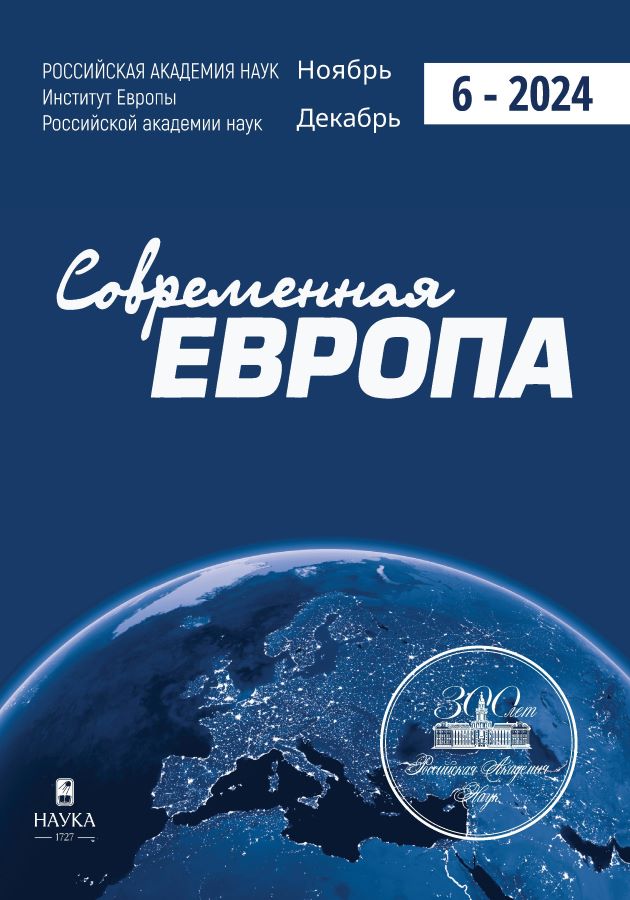EU‒Africa Relations: Migration Diplomacy Approach
- 作者: Bisson L.S1
-
隶属关系:
- Institute of Europe RAS
- 期: 编号 6 (127) (2024)
- 页面: 57-67
- 栏目: EUROPEAN PROCESS: COUNTRIES AND REGIONS
- URL: https://ter-arkhiv.ru/0201-7083/article/view/652296
- DOI: https://doi.org/10.31857/S0201708324060056
- ID: 652296
如何引用文章
详细
The article offers a fresh insight into the relations between the European Union and Africa from “migration diplomacy” perspective which is being introduced in migration and international relations research in Russia. The author notes the explanatory and predictive potential of the “migration diplomacy” concept for considering the complex relations between states within different migration systems. The analysis of interactions and cooperation of the EU, as a receiving side, with the states of origin and transit of international migrants in Africa allowed to highlight the specifics of the EU approach. The latter consists in using various diplomatic means and formats to address the problem of illegal immigration and reducing the number of asylum seekers in the EU. The increasing dependence of the European Union on cooperation with third countries results in the use of migration as a tool of political pressure by partner states. Intracontinental migration processes are at the centre of the migration diplomacy of the African continent, including those related to freedom of movement. Despite the differences in the approaches of the parties, the potential for cooperation lies in the development of channels for legal labour migration.
作者简介
L. Bisson
Institute of Europe RAS
Email: lyubov.pasyakina@gmail.com
Candidate of Sciences (Politics) Senior research fellow, Center for European integration studies Moscow, Russia
参考
- Биссон Л. (2018) Внешнее измерение миграционной политики ЕС: инструменты и выгоды. Научно-аналитический вестник ИЕРАН. № 5. С. 21-26.
- Войников В.В. (2024). Противодействие инструментализации мигрантов как элемент внешнего измерения иммиграционной политики ЕС. Современная Европа. № 3. С. 5-16. doi: 10.31857/S020170832403001X
- Захаров И.А., Агафошин М.М. (2024) Экстернализация политики убежища Британии после брекзита. Современная Европа. № 2. С. 114-127. doi: 10.31857/S0201708324020098
- Ивахнюк И.В. (2008) Евразийская миграционная система: теория и политика. МАКС Пресс, Москва. 191 с.
- Потемкина О. Ю. (2023) Экстернализация политики миграции и убежища в центре внимания Евросоюза. Европейский Союз: факты и комментарии. № 114. С. 66-70. doi: 10.15211/eufacts420236670.
- Потемкина О.Ю. (2018) Глобальный договор о миграции - успех или провал? Научноаналитический вестник ИЕ РАН. № 6. С. 86-91.
- Adamson F.A., Tsourapas G. (2019) Migration Diplomacy in World Politics. International Studies Perspectives. No. 20(2). P. 113-128. DOI: https://doi.org/10.1093/isp/eky015
- Greenhill K.M. (2010) Weapons of Mass Migration: Forced Displacement, Coercion, and Foreign Policy. Cornell University Press, New York, USA. 360 p.
- Kipp D., Knapp N., Meier A. (2020) Negative sanctions and the EU's external migration policy. SWP Comment. No. 34. 26.06. DOI: https://doi.org/10.18449/2020C34
- Niemann A., Zaun N. (2023) Introduction: EU external migration policy and EU migration governance: introduction. Journal of Ethnic and Migration Studies. No. 49(12). P. 2965-2985. DOI: https://doi.org/10.1080/1369183X.2023.2193710
- Tsourapas G. (2019) The Politics of Migration Interdependence in the Post-Arab Spring Middle East. The Dynamics of Regional Migration Governance. Ed. by A. Geddes, M. Vera Espinoza, L. Hadj Abdou, L. Brumat. Edward Elgar Publishing. P. 128-145.
补充文件









